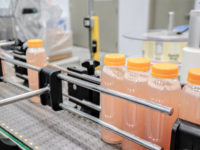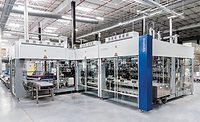Contract packers leverage reach for beverage brands
Emergent brands turn to co-packers for recipe, commercialization expertise

Forty to 45 percent of Brooklyn Bottling’s contract manufacturing business consists of canning operations, Eric Miller says. (Image courtesy of Brooklyn Bottling)
At a 6-9-1 record, the Green Bay Packers’ season last year was anything but stellar. Yet, with a new coach and the prowess of quarterback Aaron Rodgers, the team is on-pace to win the NFC North division this year. In the beverage “game,” co-packers also are exhibiting teamwork by expanding capabilities and taking on more business to help beverage brands “win” by ramping up production, distribution and the like.
Contract packing allows small, medium and large brands to outsource the packaging of their products, which is particularly important in light of the shifting beverage landscape, according to New York-based Beverage Marketing Corporation’s (BMC) October report titled “Private Label Beverages & Contract Packing in the U.S.”
The birth and rapid growth of new-age beverages, as well as the multitude of craft beer options during the past 20 years, have “moved contract packing from an activity of only occasional economic interest for most beverage plant owners to one that provides the essential foundation of a number of beverage segments,” the report states.
“The expanding spectrum of beverage introductions and packaging innovations has caused the contract packaging industry to evolve from a last resort capacity alternative to a highly specialized essential resource for brand owners,” the report states. “In spite of these changes, the industry still does not always attract the necessary capital to update, expand and bring the industry to the state-of-the-art capability.”
Gary Hemphill, manager director of research for BMC agrees: “The demand for variety has created the emergence of more categories. Most of these categories are niche with relatively low-volume opportunities,” he says. “For smaller companies entering the market, it’s preferable to opt for contract packing to avoid the cost of building production operations. Like the overall business, contract packing has gotten more complex with heightened demands for smaller runs of a range of products.”
When it comes to new product innovation, access to capital and technology provides crucial resources, according to Jeff Andrews, senior director of contract packaging at HP Hood LLC, Lynnfield, Mass. “Previously, CPG companies have had to make significant capital investments in order to innovate,” he says. “Today, contract manufacturing provides access to capacity and the latest technology without the need for up-front investment. This allows them to be more agile and obtain faster speed to market for new products.
“If you are a small company, it provides instant access to capacity and growth,” Andrews continues. “If you are a large company, a co-packer provides agility they might not otherwise have.”
In 2018, the contract packaging/contract manufacturing industry was a $59.8 billion industry, according to a PowerPoint presentation from the Reston, Va.-based Contract Packaging Association (CPA). By 2020, the CPA predicts the industry will grow to $95.5 billion at a five-year compound annual growth rate (CAGR) of 12.2 percent.
The Top 3 emerging consumer trends driving SKU proliferation — and creating new external manufacturing and packaging opportunities — are better-for-you beverages, up 40 percent; single-serve packaging, up 34 percent; and resealable packaging, up 32 percent, the presentation states.
Need for speed
CPA Managing Director Ron Puvak notes that contract packagers/contract manufacturers deliver the flexibility and agility that brand owners need to meet changing market needs.
“With the need for innovation, [consumer packaged goods] (CPGs)/[fast-moving consumer goods] (FMCGs) are transitioning from in-house manufacture to outsourced providers,” Puvak says. “The need for speed-to-market, smaller quantities, shorter runs and increased SKU counts create a situation [that] co-packers/co-manufacturers are well-positioned to fulfill.”
Whether it’s liquid refreshment beverages or spirits, “craft” is the word when it comes to innovation, Puvak says. “We see more craft beverages appearing to satisfy the new consumer (millennials) demands and tastes,” he explains. “… Craft spirits, including small-batch whiskey, flavored or infused vodkas, etc., are growing rapidly.
“Nontraditional formats for these products (e.g., pouches) has also increased,” he continues. “Some of this is being done by contract packagers. Canned wines, still small, are growing extremely fast. This is also a growth area for contract packagers.”
Eric Miller, chief executive officer for Brooklyn Bottling Co., agrees, stating that 40 to 45 percent of the Brooklyn, N.Y., plant is devoted to contract manufacturing of canned beverages. “It’s all about cans,” he says. “From energy drinks, gourmet seltzers, teas and even kombucha. We produce for the top-tier brands in the marketplace.
“What’s interesting is that for cans, we do hot-fill, we do cold-fill and we do a boutique because it’s a slower tunnel pasteurization process. We also do hot-fill PET, hot-fill glass, cold-fill glass, and we do blow molding and produce for customized beverages. So the reality is we do everything from a 64-ounce apple juice, to energy drinks, seltzers, teas and custom molding.”
To meet demand, Brooklyn Bottling is enlarging its warehousing capabilities, expanding from 125,000 square feet to 188,000 square feet by April 2020, Miller says. “This will give us the opportunity to expand our production and better service our current and future customers,” he says. “Many smaller companies are looking for storage and using packers as third-party logistics (3PL) warehouses.”
Heightened demand
Experts agree that macro trends in the overall beverage industry and the push toward more healthy alternatives is impacting the types of products they’re producing, in actuality, mirroring developments in the overall beverage marketplace.
Brett Rosenbloom, vice president of sales for Smarter Bev, the manufacturing arm of Multi-Flow, notes that the Huntingdon Valley, Pa.-based company also is “sorting out” how much space to allocate for storage of [high-fructose corn syrup] HFCS 42, 55 and cane, pointing out that the company is seeing more cane. “The other is when using natural flavors and colors, the shelf-life tends not to be as long,” he says.
Patrick Fisher, director of business development for US Hydrations, Pittston, Pa., suggests that “dollars and cents” is one of the big trends impacting contract packaging and manufacturing operations.
“There is an increased emphasis on the need for capital investment to increase capabilities,” he explains. “This is especially true in the wake of more complicated beverage processing, e.g., cold-pressed, [high-pressure processing] (HPP), [ultra-heat treatment] (UHT) and low-acid processing technologies,” he says. “There is an upsurge in requests for contract packers because the equipment to produce said beverages is expensive. There are a limited number of beverage manufacturers who can produce these types of beverages.”
Fisher notes that US Hydrations is handling more alkaline waters and cannabidiol (CBD) beverages along with spring waters, purified waters (reverse osmosis), flavored waters and carbonated beverages on four filling lines at 600 bottles per minute (bpm). To ready itself for an influx in CBD beverages, the company recently implemented a CBD beverage program 1Q2020.
Quality and flexibility matters
Along with the double-digit growth in the contract packing business, co-packers are making structural and operational changes as they expand and invest in resources to meet the evolving needs of a dynamic beverage market.
For instance, co-packagers/co-manufacturers have evolved from a “service only” mantra to helping clients from ideation to the shelf. “Emergent brands either excel at niche marketing or product development (or both), but [they] are seldom optimized for commercialization or production,” the CPA’s Puvak explains. “… From machinery to IT systems, the ecosystem of the co-packagers/co-manufacturers is getting more sophisticated and elaborate.”
Smarter Bev’s Rosenbloom notes a growth surge in the fountain business. “[Business] has gotten more robust as companies want to enter private-label for their fountain business,” he says. “Alternative products such as frozen treats has grown the business.”
Quality is top-of-mind for beverage companies and the contract packers with whom they partner. “Multi-Flow has a full lab with food technologists to help with the formulas, as well as a full [quality assurance] (QA) department so you know you are getting a quality product,” Rosenbloom says.
With seven filling lines, Multi-Flow’s operations are capable of filling 1-, 3- and 5-gallon bags, 10- and 16-ounce pouch fillers, half- and 1-gallon jug fillers and 1-gallon cartridges and caddy packs, Rosenberg says. The pasteurization of shelf-stable, bag-in-box is the company’s No. 1 request, he adds.
With 13 manufacturing facilities, HP Hood’s capabilities include extended-shelf-life and aseptic technology as well as cultured and frozen. “We are open to many categories … and willing to explore new ones that offer us potential to grow,” Andrews says.
Whether its blow molding, multipack or wraparound cartons, US Hydrations offers a wide array of co-packing equipment and processes, Fisher says. “In addition to product development, process development, shelf-life testing, commercial scale-up for new products, technology transfer and production for market testing, US Hydrations offers blow molding, shrink sleeve labels, multi-packer (six-, 12-, 18- and 24-packs) wraparound cartons and trays just to mention a few,” Fisher says.
Brooklyn Bottling’s Miller believes that the robustness of the co-packing industry will continue. “I think the entry of building a bottling facility between real estate, land, electricity and machinery has become so high that I don’t think as many people are building new plants,” he says. “A lot of brands would rather keep their money in marketing, advertising and research and development and collaborating with a co-packer enables them to accomplish that goal.
“When I invested in the can line eight years ago, I thought I had made a bad investment because cans were on the down trend at that point,” he continues. “Eventually, it was one of the best investments we made. … You really want to focus on how you can continue to produce what you do more efficiently and at a higher quality for your client. We’re busy because of the customer service and quality we provide. Our customers are the reason we can expand.” BI
Looking for a reprint of this article?
From high-res PDFs to custom plaques, order your copy today!






